One Very Possible
2011 7-Imp Retrospective Before Breakfast
 December 29th, 2011 by jules
December 29th, 2011 by jules
 It’s that time of year, dear readers. It’s when I like to look back on what happened at 7-Imp during the year and look at who graced the site with their presence—all with my buddy here, Alfred—because evidently I am slightly to moderately screwy in the head. (It’s taken me over a week just to pull all this together.) Actually, I just really enjoy end-of-the-year recaps of every kind, and—as I said in 2010’s recap post—this is my warped idea of tidy fun. Also, it satisfies the tremendous picture book junkie in me.
It’s that time of year, dear readers. It’s when I like to look back on what happened at 7-Imp during the year and look at who graced the site with their presence—all with my buddy here, Alfred—because evidently I am slightly to moderately screwy in the head. (It’s taken me over a week just to pull all this together.) Actually, I just really enjoy end-of-the-year recaps of every kind, and—as I said in 2010’s recap post—this is my warped idea of tidy fun. Also, it satisfies the tremendous picture book junkie in me.
As my regular readers know, I am devoted here at 7-Imp to focusing on contemporary illustration (well, not always contemporary — there are some exceptions) — with a particular focus on picture books. So, even though I certainly didn’t have the time to cover every book I wanted to discuss, not to mention I didn’t read every picture book created in 2011, 7-Imp end-of-year recaps can be an awful lot like looking back at the state of picture books during a given year, which I also find really fun. That’s one way of saying: This long post is good for browsing, especially if you like to see picture book art.
If I take a look at what was new to 7-Imp in 2011—before we look at who visited, that is, and all kinds of artwork—I run the risk of actually sounding organized, which I’m not. Or as if I’m someone who blogs 40 hours a week, which I’m also not. Since blogging comes after my children, the work-that-pays, and other things that allow me to have a life, I’m kind of scattered, have no real 7-Imp Action Plans, and you should just see my system of organization (chicken-scratch-scrawled Post-it notes stuck all over my very messy desk). But let me give this a shot anyway, an attempt to ponder what was new in 2011:
 Further progress with Elizabeth Bird and Peter D. Sieruta on this book, coming your way in 2013 from Candlewick. In fact, instead of organizing a massive recap right now, I should be editing, but shhh … don’t tell our wonderful editor.
Further progress with Elizabeth Bird and Peter D. Sieruta on this book, coming your way in 2013 from Candlewick. In fact, instead of organizing a massive recap right now, I should be editing, but shhh … don’t tell our wonderful editor.
 In August, I served with the smart folks below as a jury member for the Society of Illustrators’ 2011 Original Art award, which was much fun. We look tired here, but this was taken after a long (but wonderful) day of looking at precisely one skerjillion tall stacks of picture books:
In August, I served with the smart folks below as a jury member for the Society of Illustrators’ 2011 Original Art award, which was much fun. We look tired here, but this was taken after a long (but wonderful) day of looking at precisely one skerjillion tall stacks of picture books:

John Bemelmans Marciano.
 In March of this year, I started writing a weekly column over at Kirkus in their new Book Blogger Network. I archive those columns here at this page of 7-Imp’s site. (I’m a librarian by training. I can’t help but list.)
In March of this year, I started writing a weekly column over at Kirkus in their new Book Blogger Network. I archive those columns here at this page of 7-Imp’s site. (I’m a librarian by training. I can’t help but list.)
 The addition of a new Mad Tea Party image, created specifically for 7-Imp in February of this year, by author/illustrator Aaron Zenz and placed on this page of the site. (Follow this link—scroll to bottom of post—to get the story behind this particular mad tea party and why, for instance, there’s a baby oyster at the mad gathering.) Big thanks to Aaron!
The addition of a new Mad Tea Party image, created specifically for 7-Imp in February of this year, by author/illustrator Aaron Zenz and placed on this page of the site. (Follow this link—scroll to bottom of post—to get the story behind this particular mad tea party and why, for instance, there’s a baby oyster at the mad gathering.) Big thanks to Aaron!

 This year, Italian blogger and picture book aficionado Cristiana Clerici (pictured below) of The Tea Box, who contributes book reviews and interviews here at 7-Imp whenever her schedule allows and when inspiration strikes, conducted fabulous interviews with international picture book artists — Spanish illustrator Javier
This year, Italian blogger and picture book aficionado Cristiana Clerici (pictured below) of The Tea Box, who contributes book reviews and interviews here at 7-Imp whenever her schedule allows and when inspiration strikes, conducted fabulous interviews with international picture book artists — Spanish illustrator Javier  Zabala in February and Italian illustrator Maurizio Quarello in May. In January she discussed Barbe Bleue by Charles Perrault, illustrated by Maurizio Quarello, which led to a good discussion (in the comments) about whether or not we Americans are too squeamish (compared to Europeans) about producing picture books with dark subject matter. Once again, I thank Cris for contributing when she can, especially given her own wonderful blog and busy schedule. It is such a treat when she visits 7-Imp. I heart her.
Zabala in February and Italian illustrator Maurizio Quarello in May. In January she discussed Barbe Bleue by Charles Perrault, illustrated by Maurizio Quarello, which led to a good discussion (in the comments) about whether or not we Americans are too squeamish (compared to Europeans) about producing picture books with dark subject matter. Once again, I thank Cris for contributing when she can, especially given her own wonderful blog and busy schedule. It is such a treat when she visits 7-Imp. I heart her.
 My friends joined me this September in making a not-so-subtle plea to the Library of Congress.
My friends joined me this September in making a not-so-subtle plea to the Library of Congress.
 I got to speak about children’s literature at various conferences and in various places and at various schools, most recently (this month) at this wonderful school here in Middle Tennessee. Second-grade teachers there are doing a unit on picture books and the Caldecott award, and I was one of several people who spoke to the second-graders, who were so well-versed in illustration and picture books that it was a thing of beauty, I tell you. May we have the ability one day to clone these teachers.
I got to speak about children’s literature at various conferences and in various places and at various schools, most recently (this month) at this wonderful school here in Middle Tennessee. Second-grade teachers there are doing a unit on picture books and the Caldecott award, and I was one of several people who spoke to the second-graders, who were so well-versed in illustration and picture books that it was a thing of beauty, I tell you. May we have the ability one day to clone these teachers.

 What was that? You missed the July spotlight on Literacyhead? Shoo. Go read! (Please? It’s a good group of people.)
What was that? You missed the July spotlight on Literacyhead? Shoo. Go read! (Please? It’s a good group of people.)
 I only pulled off one picture book roundtable discussion this year, earlier in 2011. Er, remember my note about not being tremendously organized? But those are so much fun that I’ll try to do more in 2012.
I only pulled off one picture book roundtable discussion this year, earlier in 2011. Er, remember my note about not being tremendously organized? But those are so much fun that I’ll try to do more in 2012.
 The talented guys over at The Bluegrass Special are still including one of my 7-Imp posts in their wonderful publication — on a monthly basis. I also became an advisory board member for Poetry Advocates for Children & Young Adults, or PACYA. More information on that is here in my November interview with the very busy Steven Withrow.
The talented guys over at The Bluegrass Special are still including one of my 7-Imp posts in their wonderful publication — on a monthly basis. I also became an advisory board member for Poetry Advocates for Children & Young Adults, or PACYA. More information on that is here in my November interview with the very busy Steven Withrow.
 7-Imp turned five years old.
7-Imp turned five years old.
It makes me happy to wake up every morning, get online, and discuss picture books and illustration with 7-Imp readers. Thank you all for joining me.
Let’s get to it. First, who visited me in 2011? I had a lot of coffee at the cyber-breakfast table this year …
Author/Illustrator Geneviève Côté (July 14, 2011), pictured above: “I have the utmost respect for all medical professions, and as an illustrator, I’m grateful that my worst mistake will probably never be more serious than drawing a dog that looks like a misshapen kangaroo.”
(Click to enlarge)
Author and poet Marilyn Singer, pictured below (March 11, 2011): “I’m…interested in many genres of writing and which works best for each subject I’m exploring. I don’t like to bore other people, and I don’t like to bore myself, so I’m always looking for new challenges, whether they be the challenge of doing research, which I liken to detective work, or of digging deep to create fictional characters, or of attempting to write in forms I haven’t yet explored.”

Author/Illustrator Brian Selznick (October 27, 2011): “When I made Hugo, I had a very good career before it, but nobody was looking forward to Hugo. Hugo kind of built its own momentum, once people heard about it and saw what it was. But with Wonderstruck, most people, amazingly, now know Hugo,  and I knew that they would want to see what it was that might come next. So, I certainly was aware that there was going to be a kind of pressure on the next book that was not there for Hugo, and I can say that there was also a certain worry that came along with that. But when it was time for me to actually sit down at my desk with the blank piece of paper and the computer and my pencil and eraser, I can honestly say that the only thing that mattered was what this story was going to be. Again, it was three years of terror, but it was the same terror I had experienced making Hugo, and it’s the terror of trying to get everything right for the book. It’s the terror of not knowing if it’s going to come together. But the terror, of course, is made palatable by the fact that I’m doing something that I love, and I’m writing about things that I love, and I’m creating characters that I love, and I’m getting to research topics that I’m fascinated by. So, there is that love that carries you through it, but there is the real fear that it’s not going to come together.”
and I knew that they would want to see what it was that might come next. So, I certainly was aware that there was going to be a kind of pressure on the next book that was not there for Hugo, and I can say that there was also a certain worry that came along with that. But when it was time for me to actually sit down at my desk with the blank piece of paper and the computer and my pencil and eraser, I can honestly say that the only thing that mattered was what this story was going to be. Again, it was three years of terror, but it was the same terror I had experienced making Hugo, and it’s the terror of trying to get everything right for the book. It’s the terror of not knowing if it’s going to come together. But the terror, of course, is made palatable by the fact that I’m doing something that I love, and I’m writing about things that I love, and I’m creating characters that I love, and I’m getting to research topics that I’m fascinated by. So, there is that love that carries you through it, but there is the real fear that it’s not going to come together.”
(Click to enlarge)
 Author/Illustrator Nina Crews (June 21, 2011) on her road to publication: “It is the family business; I am the daughter of Donald Crews and Ann Jonas. I didn’t originally plan on following so closely in their footsteps. After college, I tried out a few applied art jobs – I worked for animation studios and did some photocollage illustrations for magazines….I took part in a fine art studio program run by the Whitney Museum. It was only after I felt more certain of my voice and vision that I entertained the possibility of picture books.
Author/Illustrator Nina Crews (June 21, 2011) on her road to publication: “It is the family business; I am the daughter of Donald Crews and Ann Jonas. I didn’t originally plan on following so closely in their footsteps. After college, I tried out a few applied art jobs – I worked for animation studios and did some photocollage illustrations for magazines….I took part in a fine art studio program run by the Whitney Museum. It was only after I felt more certain of my voice and vision that I entertained the possibility of picture books.
Around that time, my father recommended me to illustrate a manuscript that he wasn’t interested in. I got an interview to show my portfolio to Susan Hirschman and Ava Weiss at Greenwillow Books. They asked me if I had written anything of my own and sent me home with a date to come back one month later with an idea. The idea I brought in was One Hot Summer Day.”

The Neighborhood Sing-Along (Greenwillow, May 2011)
I mouse you. Mama said, Why don’t I write you a letter to say hello, so I am.“
Author/Illustrator David Ezra Stein (November 27, 2011) on Love, Mouserella (Nancy Paulsen Books/Penguin, September 2011), pictured above: “The book began with the idea of a young mouse taking an imaginary trip to see her Grandmouse. She goes on a train from city to country. Grandmouse has written her a letter, which serves as a guide for what she’ll do on the trip. Somewhere along the way, I realized Mouserella wanted to tell me her story. She wanted to be the one writing the letter, and thus the book came into its own.”
 Author/Illustrator John Rocco (May 31, 2011): “What I love about Brooklyn is the sheer number of book illustrators that live here. Over the last seven years, I have been lucky enough to meet and become good friends with many of them. My friend, Brian Floca, has a studio almost next door to mine. After this breakfast, I will probably go have lunch with him. (When will I get ANY work done with all of these meals to schedule?) On Fridays I usually get together with John Bemelmans Marciano so that our daughters can have a play date and we can scheme new ways to make better books. Just the other day my wife, Aileen Leijten, and I had fourteen illustrators over for a pot luck dinner and p.r. discussion. Sophie Blackall brings the wine, Sergio Ruzzier brings the cheese, and I provide the whiskey. Good times.”
Author/Illustrator John Rocco (May 31, 2011): “What I love about Brooklyn is the sheer number of book illustrators that live here. Over the last seven years, I have been lucky enough to meet and become good friends with many of them. My friend, Brian Floca, has a studio almost next door to mine. After this breakfast, I will probably go have lunch with him. (When will I get ANY work done with all of these meals to schedule?) On Fridays I usually get together with John Bemelmans Marciano so that our daughters can have a play date and we can scheme new ways to make better books. Just the other day my wife, Aileen Leijten, and I had fourteen illustrators over for a pot luck dinner and p.r. discussion. Sophie Blackall brings the wine, Sergio Ruzzier brings the cheese, and I provide the whiskey. Good times.”
(Click to enlarge)
— One of Rocco’s illustrations from John and Katherine Paterson’s The Flint Heart (Candlewick, September 2011)
(Click to enlarge)
Illustrator Beth Krommes (September 20, 2011):  “Scratchboard is a black-and-white drawing medium. The board itself is a cardboard or panel with a thin veneer of fine, white clay covered by a layer of india ink. The drawing surface starts completely black. The drawing is made by scratching white lines through the ink with a scratchboard nib held in a pen holder. The more lines that are drawn, the brighter the picture becomes. The clay coating under the ink allows the sharp point to remove the ink easily without tearing the board support. A scratchboard drawing is often very highly detailed and can resemble a wood engraving.”
“Scratchboard is a black-and-white drawing medium. The board itself is a cardboard or panel with a thin veneer of fine, white clay covered by a layer of india ink. The drawing surface starts completely black. The drawing is made by scratching white lines through the ink with a scratchboard nib held in a pen holder. The more lines that are drawn, the brighter the picture becomes. The clay coating under the ink allows the sharp point to remove the ink easily without tearing the board support. A scratchboard drawing is often very highly detailed and can resemble a wood engraving.”

— Spread from Joyce Sidman’s Swirl by Swirl: Spirals in Nature
(Houghton Mifflin, October 2011)

Author/Illustrator Craig Frazier (June 9, 2011) on the publication of Bee and Bird, pictured above: “[Neal Porter of Roaring Brook and I] decided very early that this book would be all about the visual surprise of turning the page and that the illustrations would be very simple — graphic and always hint to the next landscape. 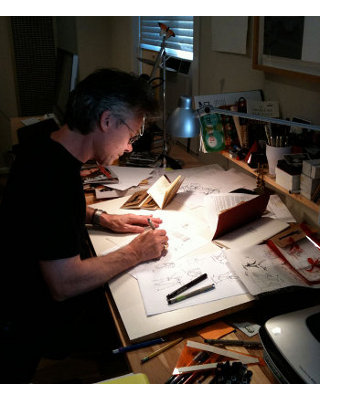 I happen to love super simple visuals, perhaps a throwback to my early years as a designer when Swiss design was in style. These illustrations are reduced to the fewest elements and created very graphically with straight lines and sensual radiused corners — almost architectural. Perhaps a reaction to the computer, they were all drawn with drafting tools and scanned retaining the pen’s fuzzy edge and colored with primary colors. Each spread changes the viewer’s point of view as well as scale. My hope is that the mystery of each form prompts personal storytelling by the kids (or parents), depending on what they happen to see. This also points to our decision to make it a wordless book. It is a challenge I give myself, even with written books: ‘Does this story hold up solely on the merits of the illustrations?’…I have learned from my years as a designer to trust the sense of scale and proportion that I work out in my thumbnails. It’s always the same, whether designing a poster or a postage stamp. I suppose that is why I sketch so small and in such small sketchbooks.”
I happen to love super simple visuals, perhaps a throwback to my early years as a designer when Swiss design was in style. These illustrations are reduced to the fewest elements and created very graphically with straight lines and sensual radiused corners — almost architectural. Perhaps a reaction to the computer, they were all drawn with drafting tools and scanned retaining the pen’s fuzzy edge and colored with primary colors. Each spread changes the viewer’s point of view as well as scale. My hope is that the mystery of each form prompts personal storytelling by the kids (or parents), depending on what they happen to see. This also points to our decision to make it a wordless book. It is a challenge I give myself, even with written books: ‘Does this story hold up solely on the merits of the illustrations?’…I have learned from my years as a designer to trust the sense of scale and proportion that I work out in my thumbnails. It’s always the same, whether designing a poster or a postage stamp. I suppose that is why I sketch so small and in such small sketchbooks.”


 Illustrator Carson Ellis (May 17, 2011): “I’ve illustrated both picture books and chapter books. They’re so different but, for me, the differences have more to do with the function of the illustration in each than their audience. I think picture books are harder. They need to have a visual arc that matches their story arc. The text and the images are interdependent. Any given page has a relationship to the page that came before and the one that comes after. There’s a craft to it that I think the casual reader might take for granted.”
Illustrator Carson Ellis (May 17, 2011): “I’ve illustrated both picture books and chapter books. They’re so different but, for me, the differences have more to do with the function of the illustration in each than their audience. I think picture books are harder. They need to have a visual arc that matches their story arc. The text and the images are interdependent. Any given page has a relationship to the page that came before and the one that comes after. There’s a craft to it that I think the casual reader might take for granted.”


from Colin Meloy’s Wildwood (Balzer + Bray, August 2011)
Carson: “I love pen and ink and pencil and gouache
equally and in various combinations.”
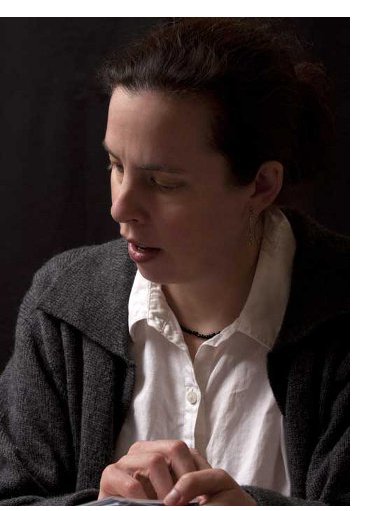 Author/Illustrator Barbara Lehman (September 12, 2011): “I got my first book job when I was around 25. It was an alphabet book. This was in the 1980s, so my road to publication was very old school: I looked at picture books in libraries and would write down the publishers’ names of the books I liked. Then I would look them up in the phone book and call to make arrangements to bring my portfolio around.
Author/Illustrator Barbara Lehman (September 12, 2011): “I got my first book job when I was around 25. It was an alphabet book. This was in the 1980s, so my road to publication was very old school: I looked at picture books in libraries and would write down the publishers’ names of the books I liked. Then I would look them up in the phone book and call to make arrangements to bring my portfolio around.
I lived in Brooklyn at the time and would travel to Manhattan to use the white pages in the library in order to get the phone numbers. I didn’t realize you could get phone books for other areas besides your own!
Compared to all this, the internet is like being at Hogwarts.”
(Click to enlarge and see entire spread from which this illustration comes.)

Author/Illustrator Betsy Lewin, who visited with author Leslie Muir, on November 1, 2011: “I live in a four-story brownstone house with my husband Ted, who is also a children’s book author and illustrator, and our cat Sophie. My studio is on the 3rd floor. It’s a 9 X 12 foot space with a window that overlooks our maple tree and garden, a wall of bookshelves that house our own books and our collection of books done by other authors and illustrators, and my drawing table. I surround myself with mementos of the travels Ted and I have taken around the world and bits and pieces of other treasures. Sophie divides her time between Ted’s and my studios when we’re working. She’s a good muse.”
Author/Illustrator Marc Rosenthal (October 4, 2011), pictured below: “My mediums have changed and continue to change. I had mostly worked in ink and watercolor, adding pencil shading for Phooey! and Archie. For the Bobo books, I used a much more casual pencil and digital process. I am not sure what I will use next. Maybe I will draw with my own blood.”

— From Alison McGhee’s Making a Friend (Atheneum, October 2011),
illustrated by Marc Rosenthal
(Atheneum, January 2011)
(Click to enlarge spread)

Author/Illustrator James Ransome (June 2, 2011), pictured below: “I like to equate my process with the making of banana walnut bread. The dummy is like gathering all the ingredients, sometimes going through three to four changes. (Trying to find bananas at just the right ripeness and walnuts takes time.) Then the models come in for a photo shoot, which is like carefully measuring all the ingredients. Drawing the images is like the process of mixing all the ingredients: a pinch of this a cup of that. Sometimes I find myself flipping things around, stirring up my ideas until they’re well-blended and the images come to life. Maybe I’ll decide to experiment on the composition, like adding pecans in addition to the walnuts. Once the bread mixture is ready, it’s placed in the oven — the painting process is the baking. This part of the creation process takes 3-4 months of intensive work. Then the warm bread is shipped off to the publisher, who then adds ice cream and other goodies and serves it to the waiting public.”

to hear the orchestra perform.”
— From Lisa Cline-Ransome’s Before There Was Mozart: The Story of Joseph Boulogne, Chevalier de Saint-George, illustrated by James Ransome
(Schwartz & Wade, January 2011)
(Click to enlarge)
 Illustrator Rafael López (November 23, 2011): “I’m passionate about working with kids, teachers, and librarians. We tell stories, paint murals, and do workshops where we play drawing and painting games and talk a lot about color. These encounters are quirky, unpredictable, and just plain magic. I know how lucky I am to paint for kids, and I want my illustrations to inspire and challenge them. Children are more likely to trust their emotions and respond with fresh eyes, and I find myself constantly challenged to spend time trying to think the way they do….When I am painting murals, I connect to my Mexican heritage and I want to involve kids and the community in this process. With so many educational cutbacks, there aren’t enough opportunities for children, families, and teachers to make art. I like to come in and craft that experience, hopefully creating a lasting memory, pride, and excitement in their work.”
Illustrator Rafael López (November 23, 2011): “I’m passionate about working with kids, teachers, and librarians. We tell stories, paint murals, and do workshops where we play drawing and painting games and talk a lot about color. These encounters are quirky, unpredictable, and just plain magic. I know how lucky I am to paint for kids, and I want my illustrations to inspire and challenge them. Children are more likely to trust their emotions and respond with fresh eyes, and I find myself constantly challenged to spend time trying to think the way they do….When I am painting murals, I connect to my Mexican heritage and I want to involve kids and the community in this process. With so many educational cutbacks, there aren’t enough opportunities for children, families, and teachers to make art. I like to come in and craft that experience, hopefully creating a lasting memory, pride, and excitement in their work.”

illustrated by Rafael López (Charlesbridge, February 2011)
Author Candace Fleming (April 29, 2011) on Amelia Lost: The Life and Disappearance of Amelia Earhart (Schwartz & Wade, February 2011): “[T]he importance of biography is to learn about people just like us, imperfect people who overcome all sorts of obstacles to accomplish great things. Amelia Earhart was imperfect. That’s what makes hers such a complex and compelling story.”

(First Second, July 2011)
Author/Illustrator George O’Connor at Kirkus on July 8, 2011 with a follow-up post here at 7-Imp on July 15, 2011: “At heart, there is probably nothing in this world I love more than writing and drawing about the Greek myths. I, like many little boys, had always loved to draw pictures of muscle men fighting monsters, and when I was first introduced to the myths in fourth grade, they, by default, became my favorite thing to draw — and have pretty much remained that way until now. I’m also like the geekiest guy you’ll ever meet (and I mean that in a good way) and I just love hiding all these little Easter eggs in my books to reward the careful readers.”

— From Lauren Thompson’s One Starry Night,
illustrated by Jonathan Bean (Margaret K. McElderry, October 2011)
Author/Illustrator Jonathan Bean (December 13, 2011): “In a picture book so much more is communicated with sequential images—in what is usually a short length—that much of my time is spent simply figuring out what to include or drop. It’s more like solving a puzzle.”
Author/Illustrator Jarrett J. Krosoczka (October 10, 2011) on Ollie the Purple Elephant (Knopf, October 2011): “I came up with the idea for Ollie on the flight back from my honeymoon, when my newly-minted wife suggested I draw an elephant.”



Author/Illustrator Katherine Tillotson (April 5, 2011), pictured cooking paste above, at the release of George Ella Lyon’s All the Water in the World (Atheneum, March 2011): “The final art…was collaged from hand-patterned papers. Among these are patterned paste papers. Paste paper is a 400-year-old technique for hand-patterning paper. Over the years these papers were most often used as endpapers. I cook up a recipe of flour and water and then add color. Once applied to the paper you can stamp, drag, sponge and comb patterns into the paste. Very messy and very fun. All this came together in the computer, where I cut and pasted and arranged until we were all happy with the compositions.”
Author Jack Gantos (July 8, 2011): “As for being a ‘Bluebird’ reader when I was a child—which was the slow reading group—all I have to say is that I have not been underserved by being a slow reader, because the result of being slow is that I fully consume a book when I read it. I poke my head in the white space between the words, and in the horizontal space between the lines, and sniff all along the margins like a dog taking a walk. I love taking the time for the book to cook in my imagination. I feel in no rush to blast through a book, because how then could you possibly fully imagine every little fantastic detail which is taking place in a novel. Yes, everyone loves riding the plot line, but the true imaginative marrow of a book is found off the plot—for instance, when you read the description of a wicked character standing in a kitchen and how that character breathes and carves up a fist of cheese with a knife and swallows without chewing and moves his eyes in a mean way as he tears bread apart with small hands and thinks of someone he loathes–it is important to fully see this unfold in your mind as well as the thousands of other off-plot details which make up a true book—and by ‘true book’ I mean the book that you create in your own mind, the book that you keep in your mind long after you have finished running your eyes over the printed text. It is the imaginative imprint on the paper in your own mind that is the truth of that book to the reader.
So if you read too fast and rush through the book like a trained monkey, you may be able to answer a few questions on a test—but that is not the same as being captured for life by the pleasure of a good book.”
 Author/Illustrator Deborah Freedman (November 15, 2011): “[T]he one major thing that I have to add about process is that throughout, and always, I read and look at art. Perhaps it’s partly my background in art history and architecture that have given me such huge respect for precedent, but I always begin with the assumption that whatever I’m trying to do has been done before in some way or another and that if I can find the right examples, they will give me some guidance. Then, once my books are out in the world, I like to think of them as small, shy things, trying to enter a conversation with the big kids.”
Author/Illustrator Deborah Freedman (November 15, 2011): “[T]he one major thing that I have to add about process is that throughout, and always, I read and look at art. Perhaps it’s partly my background in art history and architecture that have given me such huge respect for precedent, but I always begin with the assumption that whatever I’m trying to do has been done before in some way or another and that if I can find the right examples, they will give me some guidance. Then, once my books are out in the world, I like to think of them as small, shy things, trying to enter a conversation with the big kids.”
— From Deborah’s Blue Chicken (Viking, September 2011)
(Click to enlarge spread)

Author/illustrator Jim Averbeck at the release of Except If (Atheneum, January 2011) — as brought to 7-Imp by “Guest Interviewer” Jessica Wiggebotham-Whyte, MLIS, pictured above, on April 25, 2011: “I thought about how conversations with young children often  go. They hitch one thought on the back of another unendingly, like a train with no caboose. I wanted to capture that sort of mental process. So, I decided to see if I could make a story out of one long run-on sentence with a surprise after each turn of the page — and the words ‘except if’ connecting the whole thing together. Of course, I had to create a caboose, because a picture book has a finite number of pages. I thought about a lecture I once heard by Richard Peck, where he stated ‘the beginning is the end in disguise’ and the lectures I myself had given on circular story structure. It seemed to me that a circular ending was perfect if I was trying to imitate a child’s thought patterns, because a circle gives closure but also implies a sort of infinite loop.”
go. They hitch one thought on the back of another unendingly, like a train with no caboose. I wanted to capture that sort of mental process. So, I decided to see if I could make a story out of one long run-on sentence with a surprise after each turn of the page — and the words ‘except if’ connecting the whole thing together. Of course, I had to create a caboose, because a picture book has a finite number of pages. I thought about a lecture I once heard by Richard Peck, where he stated ‘the beginning is the end in disguise’ and the lectures I myself had given on circular story structure. It seemed to me that a circular ending was perfect if I was trying to imitate a child’s thought patterns, because a circle gives closure but also implies a sort of infinite loop.”

Author/Illustrator Lita Judge (December 8, 2011): “I studied to be a geologist and worked on dinosaur digs, so I never imagined I’d get to be a writer and illustrator. But after dinner one night I was washing the dishes and said one too many times to my husband that, if I could do anything in the world, I’d love to write and illustrate children’s books. He threw the dish towel down and said, ‘just do it.’ I began working on my first book the next day. That book never got published, but the dummy got me my first illustration job.”

 Illustrator Sonia Lynn Sadler, pictured left, on April 7, 2011: “Three Little Girls [pictured above] is an example of my pencil drawings that I do mainly for myself. Pencil drawing is the way I started out in my fine art training. These were little girls on the side of the road in Jamaica, having a snack after church.”
Illustrator Sonia Lynn Sadler, pictured left, on April 7, 2011: “Three Little Girls [pictured above] is an example of my pencil drawings that I do mainly for myself. Pencil drawing is the way I started out in my fine art training. These were little girls on the side of the road in Jamaica, having a snack after church.”
Author Julie Sternberg, who visited with author/illustrator Matthew Cordell (March 23, 2011) at the release of Like Pickle Juice on a Cookie (Amulet, March 2011), pictured below: “Now, as I flip through the newly printed hardcover of Pickle Juice, I feel so grateful to my editor for choosing Matt, and to Matt for agreeing to sign on. How many times have I looked at these pictures? How is it possible that so many of them still make me laugh? … None of the illustrations undercut the sentiment of the story, either; and several deepen it….For a first-time author with relatively little ultimate control in the publishing process, it can be frightening to know that someone else’s creative vision will shape the presentation of your book. I got so lucky! Here’s hoping that luck holds for many future projects.”


 Author/Illustrator Jon Klassen (August 18, 2011), pictured above: “Illustrating a book, if it’s somebody else’s text, usually starts with just figuring out the tone of it. I’ve been lucky to have gotten books that are all very different from each other, so this has been a different experience every time. Dividing out the pages, pacing it, and figuring out the visual rules of the story are my favorite parts, probably. You can solve so many problems for yourself at that stage. It’s where the biggest decisions are made, and I’m constantly reminded that if you think you’re going to fix something when you’re trying to make it pretty later on, it never works. I like showing the roughs to people and seeing where I cringe or feel the need to explain or defend something in them, because then you know where your trouble spots are.”
Author/Illustrator Jon Klassen (August 18, 2011), pictured above: “Illustrating a book, if it’s somebody else’s text, usually starts with just figuring out the tone of it. I’ve been lucky to have gotten books that are all very different from each other, so this has been a different experience every time. Dividing out the pages, pacing it, and figuring out the visual rules of the story are my favorite parts, probably. You can solve so many problems for yourself at that stage. It’s where the biggest decisions are made, and I’m constantly reminded that if you think you’re going to fix something when you’re trying to make it pretty later on, it never works. I like showing the roughs to people and seeing where I cringe or feel the need to explain or defend something in them, because then you know where your trouble spots are.”
Anne Schwartz and Lee Wade, creators of Random House’s Schwartz & Wade imprint, celebrate the imprint’s fifth anniversary and share why they love picture books (June 20, 2011): “We love that each picture book is a self-contained world. So much has to happen in just 32 pages. In a good picture book, each word is chosen carefully, every word is necessary….And when an illustrator takes a strong text and extends it, the book really starts to sing. It’s like magic when text and art come together to create something greater than either one of its parts.”
April Stevens’ Edwin Speaks Up, illustrated by Sophie Blackall
(Click to enlarge spread)
 Author/Illustrator Shadra Strickland (November 8, 2011): “I begin every process with research. For books like Bird, Hurricanes, and White Water, I take a few days to explore the places where the story takes place. I walk the streets with my camera and sketchbook, collecting ideas and inspiration for the images. The more info I gather, the easier it is to express myself with the art. I also look at other artists and storytellers who have worked with similar subject matter.”
Author/Illustrator Shadra Strickland (November 8, 2011): “I begin every process with research. For books like Bird, Hurricanes, and White Water, I take a few days to explore the places where the story takes place. I walk the streets with my camera and sketchbook, collecting ideas and inspiration for the images. The more info I gather, the easier it is to express myself with the art. I also look at other artists and storytellers who have worked with similar subject matter.”

— From Michael S. Bandy’s and Eric Stein’s White Water
(Candlewick, August 2011)
Author/Illustrator Mini Grey (May 8, 2011) at the release of Three By the Sea (Knopf, April 2011): “It’s a funny (strange) sort of story. I was thinking about a mismatched sort of family of a white dog, a black cat, and a little grey mouse, who live together in a beach hut. Traditionally, dogs, cats, and mice are supposed to be sworn enemies, but these ones don’t know that. They all have their own jobs to do and live happily together — until a stranger blows in one night and disrupts their comfortable existence. They look again at their household set-up and start to find it wanting. Seeds of discontent have been sown.”
(Click each to enlarge)
Author Jeanne Walker Harvey (December 4, 2011) on Elizabeth Zunon’s illustrations for My Hands Sing the Blues: Romare Bearden’s Childhood Journey (Marshall Cavendish, September 2011), pictured below: “I think Elizabeth Zunon’s illustrations are stunning. It was a picture book author’s dream come true to open the packet from the publisher and see her illustrations. Not only do Liz’s illustrations embody the spirit of Romare Bearden’s art, but they truly bring the text to life.”
and nothing goes to waste.”
(Click to enlarge)
Author/Illustrator Bonnie Christensen (June 3, 2011) on Fabulous! A Portrait of Andy Warhol (Christy Ottaviano Books/Henry Holt, May 2011): “The artwork was a complicated process. I wanted to create a sense of Warhol’s work, so I started with black and white photos which I collaged. As you can see, the figures are drawn, then cut out and collaged onto the photo backgrounds. Black and white photocopies of the collages were then made and transferred to canvas using an acrylic medium process that no one understands when I explain it. There are many steps and lots of blogs describing exactly how it’s done. The final step is washing/scrubbing the photocopy paper off the canvas to reveal the b&w ink. I then hung my paintings out to dry, and it struck me as odd, so I took a photo.”

Glamorous celebrities and superheroes kept him company…”

‘I’ll feed my skunk every day. I promise! Really!’ says Petunia.”
— From Paul Schmid’s A Pet for Petunia (HarperCollins, February 2011)
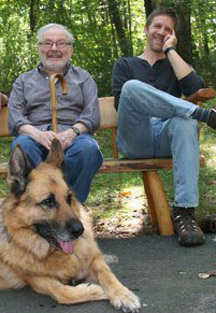 Author/illustrator Paul Schmid (February 8, 2011) on the Sendak Fellowship: “Last spring, out of the blue, I received an email informing me I was invited to spend a month with Maurice Sendak as part of the inaugural year of a thing called the Sendak Fellowship. My first response was disbelief, and then to wonder who might be playing a joke on me, but early that September I sure enough found myself in Connecticut, sitting next to Maurice Sendak, talking about books. The fellowship was one of those experiences that start out being so astounding one can hardly believe it, and end as something warm and personal and wonderful. Maurice is a funny, generous, brilliant man, who lives deeply. I’m convinced that is the reason his books are so substantial and enduring….Thoughtful, passionate, idealistic, he has lived a life of emotional and intellectual honesty and courage.”
Author/illustrator Paul Schmid (February 8, 2011) on the Sendak Fellowship: “Last spring, out of the blue, I received an email informing me I was invited to spend a month with Maurice Sendak as part of the inaugural year of a thing called the Sendak Fellowship. My first response was disbelief, and then to wonder who might be playing a joke on me, but early that September I sure enough found myself in Connecticut, sitting next to Maurice Sendak, talking about books. The fellowship was one of those experiences that start out being so astounding one can hardly believe it, and end as something warm and personal and wonderful. Maurice is a funny, generous, brilliant man, who lives deeply. I’m convinced that is the reason his books are so substantial and enduring….Thoughtful, passionate, idealistic, he has lived a life of emotional and intellectual honesty and courage.”
Author/illustrator Claire A. Nivola (March 28, 2011): “When people see your work or hear the facts of your life from the outside, they see accomplishment, certainty, a clear pattern of a life. What  they don’t know (though they may feel it about their own lives) is how the story line was not so clear, as it was lived. The pattern only appears in hindsight.
they don’t know (though they may feel it about their own lives) is how the story line was not so clear, as it was lived. The pattern only appears in hindsight.
Now as I listen to music and paint, I can say that this was just what I did as a child when my mother read me stories and I drew or when I worked in my father’s studio by his side, and that it all makes perfect sense. But what of all the detours, false starts, and other yearned-for directions? What of the twenty years totally absorbed in being a mother and never touching my brushes? What of all the ways in which we are not consistent, the impasses and changes that make the fact that our lives seem to be a solid, single story surprising — most of all, to ourselves.”
(Farrar, Straus and Giroux, July 2011)
(Click spread to enlarge)


which hit off the east coast of Japan in March of this year
 Author/Illustrator Bob Staake (December 27, 2011): “I do a lot of books and for a lot of different publishers, so I’m always trying to make each title distinctive and different from the last. I get bored very easily, so by always trying something different, I’d like to think it keeps my work fresh, unexpected, and surprising to readers….If I have done it before, it doesn’t really interest me. Too predictable. On a creative level, I hope I have evolved into an artist who takes chances, tries new approaches, and isn’t risk-averse.”
Author/Illustrator Bob Staake (December 27, 2011): “I do a lot of books and for a lot of different publishers, so I’m always trying to make each title distinctive and different from the last. I get bored very easily, so by always trying something different, I’d like to think it keeps my work fresh, unexpected, and surprising to readers….If I have done it before, it doesn’t really interest me. Too predictable. On a creative level, I hope I have evolved into an artist who takes chances, tries new approaches, and isn’t risk-averse.”
Author/illustrator Sophie Blackall (March 16, 2011) at the release of Aldous Huxley’s The Crows of Pearblossom (Abrams, March 2011), originally written in 1944 and pictured below: “The second dilemma I faced was how to deal with the ‘old-fashioned’ tone (I’m being kind) Mr. Crow uses with Mrs. Crow throughout the story. Mr. Crow, Assistant Manager at the Palmdale drug store, accuses his wife of overeating and being of doubtful intelligence. She’s not all that nice to him either, but still.
“What’s the matter, Amelia?” he said. “You look quite ill. You haven’t been overeating again, have you?”
“How can you be so coarse and unfeeling?” Mrs. Crow burst out. “Here am I, working myself to the bone for you; when I’m not working, laying a fresh egg every single day—except Sundays, of course, and public holidays—two hundred and ninety-seven eggs a year, and not a single chick hatched out. And all you can do is ask if I’ve been overeating. And when I think of that dreadful snake, I go all of a tremble.”
“Snake?” said Mr. Crow. “What snake?”
I decided to make her tower over him. She is robust and sleek. He is diminutive and scrappy. I don’t know… this made me laugh. I also packed her a suitcase and tucked it under the bed, just in case.”


somebody will have to do something about.'”
Author Catherynne M. Valente at Kirkus on September 30, 2011 with a follow-up post here at 7-Imp on October 7, 2011: “[Fairy tales] are our oldest stories, honed down through generations until they are laser-like tools for understanding human behavior, both terrible and wonderful. They are simple, but their images are primordial, essentially and utterly human. The same tales are repeated in different combinations and variations in every culture. They teach us how to survive, how to grow up, how to be honorable and how to behave when others do not treat us with honor. They are condensed gems of cultural knowledge. In a very real way, since we all grow up with them, they create our cultural psychology. And now we recombine and retell them in order to make them reflect our own culture better — where women are not necessarily only rewards and princes are not automatically just. We engage with them and challenge them so that we can pass them on, shined up and new, but still incredibly old and powerful.”

autumnal branches. Like Death’s skull. She had so little time.”
— From Catherynne M. Valente’s The Girl Who Circumnavigated Fairyland in a Ship of Her Own Making (Feiwel and Friends, May 2011), illustrated by Ana Juan
— From Hyewon Yum’s The Twins’ Blanket (Farrar, Straus and Giroux, August 2011)
(Click to enlarge spread.)
 Author/illustrator Hyewon Yum (February 17, 2011): “I studied fine art and printmaking in Korea and happened to illustrate picture books and got to know this amazing world of picture books and illustration. That’s how I decided to be an illustrator, and I came to New York and got my MFA from SVA. There I made two picture book dummies. That’s what became Last Night and There Are No Scary Wolves. My fairy godmother, Frances, published both books.”
Author/illustrator Hyewon Yum (February 17, 2011): “I studied fine art and printmaking in Korea and happened to illustrate picture books and got to know this amazing world of picture books and illustration. That’s how I decided to be an illustrator, and I came to New York and got my MFA from SVA. There I made two picture book dummies. That’s what became Last Night and There Are No Scary Wolves. My fairy godmother, Frances, published both books.”
Author/illustrator Etienne Delessert (March 10, 2011): “I am concerned. Children are also concerned. Their world is complex. They see and feel everything. They know about loneliness — or the desire to be left alone. They know about death — Grandma or the flattened squirrel on the road. They know about the joy of a fluttering smile….Kids want also to be entertained. They look at every detail again and again, a good reason to burn all those ultra-commercial, banal books produced by the publisher’s marketing department….There is a real worry here in the States about losing our creative edge as a nation: It’s about time to give kids books that are subversive, so they can ask questions, and perhaps go on asking more questions when they grow up. A mass of questions will lead to some creative answers. And jobs. Simple!”

Author/Illustrator Nicholas Gannon (July 26, 2011): “I like to write down little ideas as they come. Many of them don’t have a purpose in the beginning, aside from my desire to put them down. Afterwards, I stitch them into different stories I’m working on. Creating a story linearly is difficult for me. The lack of clarity keeps me interested and I love the surprise when things come together in a way I didn’t necessarily intend. It’s similar for drawing. If I have an idea for an image, I don’t worry about the context. I know it fits somewhere and I’ll figure that out later. My sketches are more dear to me than finished images. I find it hard to recreate the energy of a spontaneous sketch with a completed image. I’m working to find a way to merge the two that works for my world.”


Author/illustrator Elise Primavera (January 20, 2011), pictured below:
“I don’t work on a computer, so I’m still doing every thing the old-fashioned way. I cut up the text and start to figure out how it will break up and what will be on each page. I do several versions of this, trying to get the design elements of the book figured out. I’m also thinking about what medium I’ll do as well, because that will affect all sorts of things, too. I do a lot of prep work before I even think about doing a finish.”

Illustrator Elisa Chavarri, who visited with author Esmé Raji Codell (February 22, 2011) at the release of Fairly Fairy Tales (Aladdin, January 2011): “My work is mostly digital, but for this project especially I experimented quite a bit with mixed media. I scanned fabrics (like my mom’s vintage shirts!) to incorporate into the illustrations as tablecloths, clothing patterns, wallpapers and more. I took pictures of textures like my dog’s fur, or a burnt pizza crust, and even candy, to mix in with the illustrations. There are also hand-painted textures in the mix, which I’ve been using in my illustrations for some time.”

Author/Illustrator Julia Sarcone-Roach (November 20, 2011) on the creation of Subway Story (Knopf, October 2011): “[Here is] figuring out how to make a character from a subway car…”
through springs and summers, falls and winters.”
(Click to super-size)
 Author/Illustrator Kady MacDonald Denton (July 5, 2011): “I use pen and ink with watercolours on hot-pressed watercolour paper. As the painting develops, I bring in gouache, oil sticks, perhaps a bit of chalk. I used collage in one book. Sometimes an illustration slips away, and then I’ll grab anything at hand to fight to get it back. If the struggle shows, I’ll start again. I’m in that quickly-shrinking group of illustrators who doesn’t use a computer at any stage in the illustration process.”
Author/Illustrator Kady MacDonald Denton (July 5, 2011): “I use pen and ink with watercolours on hot-pressed watercolour paper. As the painting develops, I bring in gouache, oil sticks, perhaps a bit of chalk. I used collage in one book. Sometimes an illustration slips away, and then I’ll grab anything at hand to fight to get it back. If the struggle shows, I’ll start again. I’m in that quickly-shrinking group of illustrators who doesn’t use a computer at any stage in the illustration process.”

— From Tim Wadham’s The Queen of France (Candlewick, March 2011),
illustrated by Kady
Author/Illustrator Philip C. Stead (April 11, 2011), at the release of Jonathan and the Big Blue Boat (Roaring Brook, June 2011): “I begin with a very rough sketch. I use tracing paper to refine the sketch. I try not to refine too much. Refinement can sometimes steal the life out of a drawing. If I keep the sketch loose, then I’m more likely to make spontaneous decisions later in the process.”
(Click each to enlarge)
Illustrator Laura Huliska-Beith, who visited with author Kimberly Willis Holt, Editorial Director Christy Ottaviano, and designer April Ward (February 7, 2011) at the release of The Adventures of Granny Clearwater & Little Critter (Henry Holt/Christy Ottaviano Books, October 2010), pictured below: “Another challenge was trying to figure out the whole ‘look’ of the book. My normal painting style wasn’t doing it justice. The story needed more ingenuity (like Granny herself possessed!). That’s when I started combining sewing, painting, computer, and even a little cooking (the peanut brittle). I knew it was working for me when I started having fun!”

(Click to enlarge)
 Author/Illustrator Tricia Tusa (March 21, 2011) at the release of Follow Me (Harcourt, April 2011), pictured above: “I really wanted this book to have a very imperfect, hand-done quality to it, similar to the books I loved as a child. And so I decided to use an etching process. I etched the linework into a plate, rubbing inks into the line. I then rolled the plate and paper through a press. I decided on a limited palette of color and applied it as a single layer, printing one color at a time — almost like a monoprint. With this book, I wanted to try to convey, with as few of words as possible, the feeling of connection to self as a child — where all senses are fully engaged. An intensely satisfying relationship between you and yourself. One I discover daily … and still enjoy!”
Author/Illustrator Tricia Tusa (March 21, 2011) at the release of Follow Me (Harcourt, April 2011), pictured above: “I really wanted this book to have a very imperfect, hand-done quality to it, similar to the books I loved as a child. And so I decided to use an etching process. I etched the linework into a plate, rubbing inks into the line. I then rolled the plate and paper through a press. I decided on a limited palette of color and applied it as a single layer, printing one color at a time — almost like a monoprint. With this book, I wanted to try to convey, with as few of words as possible, the feeling of connection to self as a child — where all senses are fully engaged. An intensely satisfying relationship between you and yourself. One I discover daily … and still enjoy!”
Writer/Author/Graphic novelist Ben Hatke (March 15, 2011) at the release of Zita the Spacegirl (First Second, February 2011), pictured below: “By 2006, I had already been doing freelance illustration for a couple of years, but I had started to feel like I had reached this point where I either had to take my drawing up a level or find something else to do. So, I actually went to one of my old college professors for advice and told him I was thinking of applying to an architecture program, and he said, ‘don’t do it!’ — and urged me to look into the Charles Cecil Studios in Florence. Learning there is like stepping back in time, and they focus on a very traditional and academic style of drawing and painting. I loved it. It was really only a couple of months, but they were jam-packed with learning.”
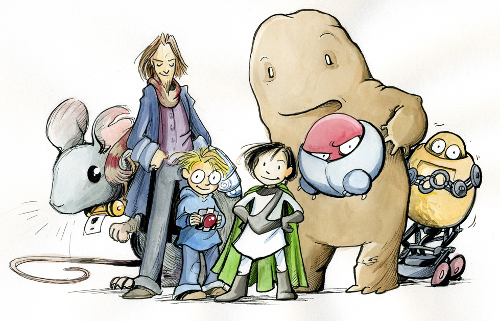
 Author/Illustrator Zachary Pullen (April 18, 2011): “I never thought I’d like the first stages of a book, although the research is the most fun now. Every book is a little different in approach. Once I’ve read the script multiple times, I usually have a mood or setting that I want to create. Then I visit my favorite place, the library. I spend hours there checking out books and looking at old articles that are going to pertain to the project. The internet has become invaluable as well, although I still like the smell of the books in the library. Plus, it means that I get to interact with people.”
Author/Illustrator Zachary Pullen (April 18, 2011): “I never thought I’d like the first stages of a book, although the research is the most fun now. Every book is a little different in approach. Once I’ve read the script multiple times, I usually have a mood or setting that I want to create. Then I visit my favorite place, the library. I spend hours there checking out books and looking at old articles that are going to pertain to the project. The internet has become invaluable as well, although I still like the smell of the books in the library. Plus, it means that I get to interact with people.”

 Author/Illustrator Nikki McClure (May 10, 2011) on school visits: “Nothing like a school full of inspired children who think that you are a magician and a rock star to enliven the day. I wish I had artists visiting me when I was young. It would have made the path a little less uncertain. Dreaming of being an Artist could have been a real possibility instead of being akin to wishing I was a Princess.
Author/Illustrator Nikki McClure (May 10, 2011) on school visits: “Nothing like a school full of inspired children who think that you are a magician and a rock star to enliven the day. I wish I had artists visiting me when I was young. It would have made the path a little less uncertain. Dreaming of being an Artist could have been a real possibility instead of being akin to wishing I was a Princess.
It also gives a sense of scale. When they started school in the last year, I started my book. Now another school year will be ending…and the book is just coming out. And that is quick. I just got The Song of Robin Hood, illustrated by Virginia Lee Burton. That took her three years just to make the pictures. What patience!”
— From Nikki’s To Market, To Market (Abrams, May 2011)
(Click to enlarge)
 Author/Illustrator Laura Ljungkvist (November 3, 2011): “I taught illustration in Stockholm for a couple of years before I moved to NY. This was a full-time, college-level graphic art school. I had graduated myself five years earlier, and some of the students were older than I. I had a blast. Working a few years, I had learned what NOT to do, and I thought I knew everything. It was great being back in a place where there are no rules and everything is possible.”
Author/Illustrator Laura Ljungkvist (November 3, 2011): “I taught illustration in Stockholm for a couple of years before I moved to NY. This was a full-time, college-level graphic art school. I had graduated myself five years earlier, and some of the students were older than I. I had a blast. Working a few years, I had learned what NOT to do, and I thought I knew everything. It was great being back in a place where there are no rules and everything is possible.”
— From Laura’s Follow the Line to School (Viking, 2011)
(Click to enlarge spread)
Debut author Molly Rausch (May 1, 2011) on her collaboration with illustrator Nora Krug on My Cold Went on Vacation (Putnam, January 2011), pictured below: “[I]t…[started] about four years ago via joking around with Nora when we were both getting over colds. I wrote her an email, saying that my cold went on vacation and I was sure it would be back soon. She answered with oh yes, I got a postcard from mine a few weeks ago. A few emails later, Nora suggested it would make a cute kids’ book. It was great fun collaborating with her! We both love to travel, and each chose certain places we definitely wanted to send our cold.”

 Author/Illustrator Anna Alter (June 19, 2011) on the publication of A Photo for Greta (Knopf, May 2011), pictured below: “My books have always had elements of my family relationships in them. Like a lot of authors, I tend to draw on my memories and experiences growing up for inspiration. But this book is perhaps the most autobiographical. Like Greta, I grew up with a dad [Gary Alter], who was a photographer. He began as a fine artist, but also did a lot of commercial work: taking pictures of basketball players at the local university, portraits of musicians for their albums, and editorial photos for magazines and newspapers. I loved to watch him work and loved posing for his photographs even more. What daughter doesn’t want to be the focus of her dad’s undivided attention, even if it is from behind a camera lens?”
Author/Illustrator Anna Alter (June 19, 2011) on the publication of A Photo for Greta (Knopf, May 2011), pictured below: “My books have always had elements of my family relationships in them. Like a lot of authors, I tend to draw on my memories and experiences growing up for inspiration. But this book is perhaps the most autobiographical. Like Greta, I grew up with a dad [Gary Alter], who was a photographer. He began as a fine artist, but also did a lot of commercial work: taking pictures of basketball players at the local university, portraits of musicians for their albums, and editorial photos for magazines and newspapers. I loved to watch him work and loved posing for his photographs even more. What daughter doesn’t want to be the focus of her dad’s undivided attention, even if it is from behind a camera lens?”

 Author/Illustrator Don Tate (December 20, 2011): “Because I’m not an illustrator with a trademark art style—and I don’t want to be—a big question for each book is what style to use. I like trying out new things. Some experiments have worked better than others, of course, but I’d much rather try something new and occasionally fail than to do the same thing book after book after book after book….With each new project, I ask myself what ‘look’ will work best for the subject matter? And how much time do I have to work with?”
Author/Illustrator Don Tate (December 20, 2011): “Because I’m not an illustrator with a trademark art style—and I don’t want to be—a big question for each book is what style to use. I like trying out new things. Some experiments have worked better than others, of course, but I’d much rather try something new and occasionally fail than to do the same thing book after book after book after book….With each new project, I ask myself what ‘look’ will work best for the subject matter? And how much time do I have to work with?”
Author/Illustrator Mélanie Watt (July 19, 2011), pictured below with a certain neurotic squirrel: “I’m fascinated with the psychology of human behavior and how we communicate. I recall moments of my childhood like it was yesterday. I remember my first day of kindergarten, what I was wearing and the nervousness I felt about dealing with the unknown. Children are really sensitive to their surroundings and experiences. These moments shape our personality and confidence as we get older and will follow us all our life. I think it’s important that books be a communication starter between adults and kids, because sharing insight and memories can bridge the gap between the generations and give a boost of confidence to kids.”
 Author/Illustrator Tim Egan (August 11, 2011) on teaching: “I…teach in the summers at Art Center, my alma mater. It’s invigorating and inspiring to see all the amazing talent out there. It can also be very intimidating when your students are so damn good. I just smile and tell them that they’re brilliant and then go to my car and cry.”
Author/Illustrator Tim Egan (August 11, 2011) on teaching: “I…teach in the summers at Art Center, my alma mater. It’s invigorating and inspiring to see all the amazing talent out there. It can also be very intimidating when your students are so damn good. I just smile and tell them that they’re brilliant and then go to my car and cry.”
Author/Illustrator Rosalyn Schanzer, Gold Medal recipient for the Society of Illustrators’ 2011 Original Art Award, on writing nonfiction (October 20, 2011): “[U]nlike the mind-numbing material you used to read in your textbooks, true stories from history can knock the socks right off your feet. After all, these tales  have lasted so long, because they include the very best—and worst—adventures of all time. Besides, you get to be a spy who can virtually take the roofs off of famous people’s houses and look inside at all their secrets without getting arrested. It’s actually legit to read their most private letters and journals or their lists of money owed or their flashes of sheer genius or their twisted evil little musings. And there’s more: Without getting decapitated, you can go along for the ride with history’s most daring explorers and warriors and earth-shakers and heroes and villains. And the art part lets you examine all their weird clothes, see what they actually looked like at different ages, and figure out how their boats and their weapons and their ceremonies and their whole strange worlds worked way back through the mists of time. In other words, it’s fun.”
have lasted so long, because they include the very best—and worst—adventures of all time. Besides, you get to be a spy who can virtually take the roofs off of famous people’s houses and look inside at all their secrets without getting arrested. It’s actually legit to read their most private letters and journals or their lists of money owed or their flashes of sheer genius or their twisted evil little musings. And there’s more: Without getting decapitated, you can go along for the ride with history’s most daring explorers and warriors and earth-shakers and heroes and villains. And the art part lets you examine all their weird clothes, see what they actually looked like at different ages, and figure out how their boats and their weapons and their ceremonies and their whole strange worlds worked way back through the mists of time. In other words, it’s fun.”

who claims that the devil himself is his servant.”

Author/Illustrator Abigail Halpin (November 30, 2011), pictured above: “I do a lot of character sketches, looking for something that speaks to me. I don’t know if it sounds strange, but it’s almost like when you sketch that character for the first time you step back and know that’s them. It’s as if they’d always existed and it was just an issue of your pencil discovering them. Sometimes it takes dozens upon dozens of sheets of paper to stumble on that, and sometimes it’s a matter of an instant.”

as filled with my favorite responses from 2011:
7-Imp: What is your favorite word?
Jonathan Bean’s “crepuscular.”
7-Imp: What is your least favorite word?
Abigail Halpin’s “ooze.”
7-Imp: What turns you on creatively, spiritually or emotionally?
Barbara Lehman: “When you are doing something unremarkable and suddenly feel a sudden and heightened sense of being alive. Like, while just sitting on a wall and talking to a friend, or coming in from the rain and shaking your umbrella, or putting water on the stove to make a pot of tea. And suddenly life feels astonishing. As if we sort of just mindlessly realize every now and then that we are on a spinning planet hurling through space, and it has HOT TEA and UMBRELLAS and FRIENDS, and it seems so absurdly, improbably and ridiculously fortunate.”
7-Imp: What turns you off?
Hyweon Yum’s “long winter’s dark clothes.”
7-Imp: What is your favorite curse word? (optional)
Not one word or phrase this year, but Barbara Lehman’s ability to use them all in “freestyle combinations.” (Runner-up: Laura Ljungkvist’s response had me scrambling for a Swedish-to-English online translator.)
7-Imp: What sound or noise do you love?
Rafael López: “A guitar riff, while sitting around the kitchen table in San Miguel de Allende.”
7-Imp: What sound or noise do you hate?
Deborah Freedman’s illustrated response, while channeling the wee protagonist of this year’s Blue Chicken (bless her, it was the first instance here at 7-Imp of an illustrated response to the Pivot Questionnaire):

7-Imp: What profession other than your own would you like to attempt?
Jon Klassen: “Physicist.”
7-Imp: What profession would you not like to do?
Jon Klassen: “Probably physicist.”
7-Imp: If Heaven exists, what would you like to hear God say when you arrive at the Pearly Gates?
Kady MacDonald Denton: “Let me tell you about one afternoon when I was visiting with my Mother, and her younger sister came to say hello. It was a glorious summer afternoon, perfect, filled with sunlight and bird song. We sat outside near a lake. My aunt was younger than my Mother but already into senility. The two old sisters chatted on about past friends when suddenly my aunt said: ‘They say Heaven is a nice place to live.’ My Mother thought this was hilarious. She laughed, just roaring away until tears rolled down. My aunt laughed also, and so did I, all of us laughing together. I remember thinking: This is heaven – such a day with such beauty, with loved ones and a cheering drink, at the meeting place between tears and laughter.”
Every Sunday at 7-Imp is still devoted to featuring the work of an illustrator, the first Sunday of the month for student or new-to-the-field artists, and here are some illustrations from this year that I particularly liked.

(Featured on July 3, 2011)

Blocked, / I can go no farther. / Fury!”
— From Patricia C. McKissack’s Never Forgotten
(Schwartz & Wade, October 2011), illustrated by Leo and Diane Dillon
(Featured on October 23, 2011)
— From Yukiko Kato’s In the Meadow (Enchanted Lion, June 2011),
illustrated by Komako Sakai
Featured April 3, 2011
(Click to enlarge spread.)

(Featured on November 6, 2011)

(Featured on March 13, 2011)

(Featured June 5, 2011)
and writes these silly poems / with invisible ink.”
— From Halfdan Rasmussen’s A Little Bitty Man and Other Poems for the Very Young, illustrated by Kevin Hawkes and translated by
Marilyn Nelson and Pamela Espeland (Candlewick, August 2011)
(Featured on October 9, 2011)
(Click to see entire spread)
— From Il Sung Na’s Snow Rabbit, Spring Rabbit: A Book of Changing Seasons (Alfred A. Knopf, January 2011)
Featured on February 27, 2011
(Click to enlarge)

‘I can’t get a moment’s peace,’ grumbled Mrs. Bendosa.”
— From Elka Weber’s One Little Chicken,
illustrated by Elisa Kleven (Tricycle Press, August 2011)
Featured August 14, 2011



From Eve Bunting’s Tweak Tweak (Clarion, May 2011), illustrated by Sergio Ruzzier
(Featured on April 24, 2011)
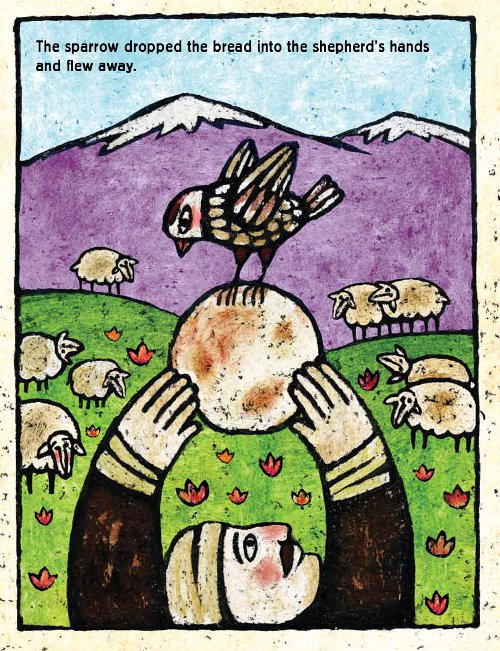
(Marshall Cavendish, April 2011), illustrated by Maria Zaikina
(Featured on August 6, 2011)

(watercolor w/digital details and text)”
— From Fabiola Garza Villalobos,
recent graduate of the Rhode Island School of Design
(Featured on February 6, 2011)
Featured June 26, 2011
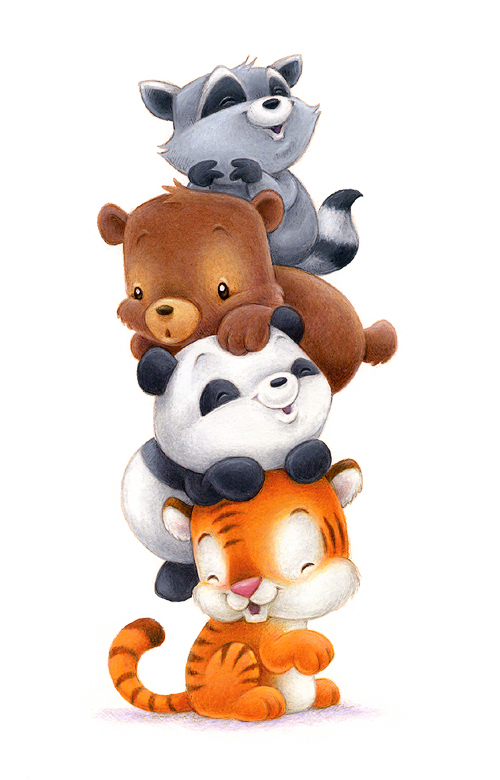
(Walker Children’s, February 2011)
Featured on February 27, 2011
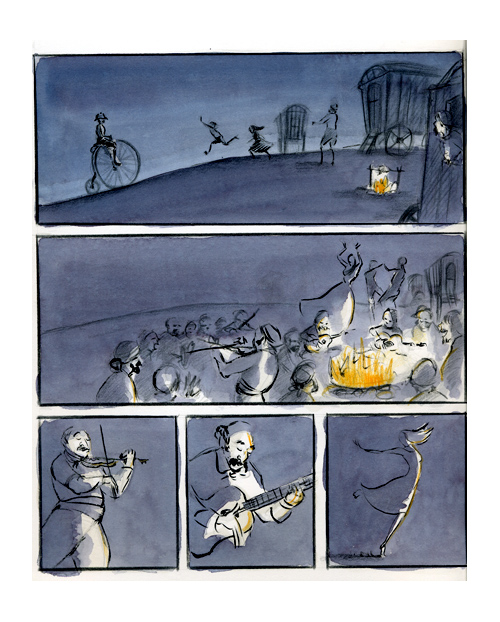
— From Matt Phelan’s Around the World (Candlewick, October 2011)
(Featured on October 16, 2011)
— From Katherine Paterson’s Brother Sun, Sister Moon, illustrated by
Pamela Dalton (Chronicle/Handprint Books, March 2011)
(Featured on July 10, 2011)
(Click to enlarge)
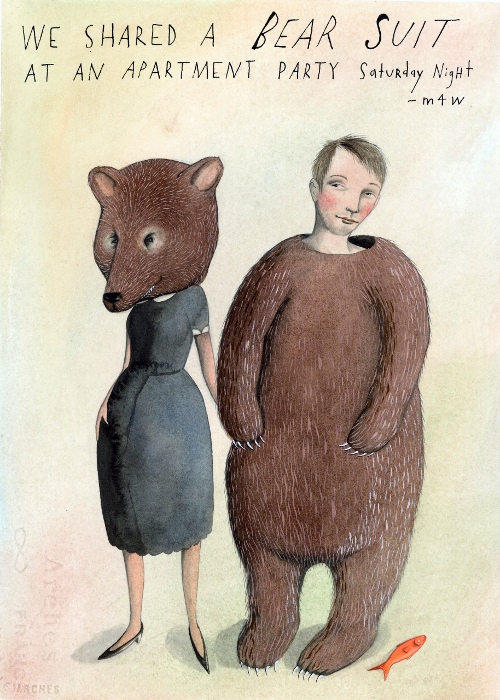
(Workman, September 2011)
(Featured on September 25, 2011)

My mother, I knew, would be angry indeed…”
— From “Steak for Supper” in The Bippolo Seed and Other Lost Stories
(Random House, September 2011)
(Featured on November 13, 2011)
And some more illustrations from the year, which just have to make a presence in this post:
(Featured on April 21, 2011)

— From Marjorie Kinnan Rawlings’ The Secret River,
newly-illustrated in January (Atheneum) by Leo & Diane Dillon
(Featured on February 1, 2011)

(Schwartz & Wade, October 2011)
Featured on November 11, 2011
— From Susan Campbell Bartoletti’s Naamah and the Ark at Night
(Candlewick, August 2011), illustrated by Holly Meade
Featured on October 28, 2011
(Click to enlarge)
The Story of America and African Americans (Balzer + Bray, September 2011)
(Featured on September 21, 2011)
(Click to enlarge and see in detail)

(Featured on June 7, 2011)


April 1, 2011; the book was later released in July…
Second image: A sneak-peek at Candace Fleming’s Fall 2012 picture book, to be illustrated by Rohmann and published by Schwartz & Wade
(Featured on May 6, 2011)

— From Lauren Castillo’s Melvin and the Boy (Henry Holt, July 2011)
(Featured on July 21, 2011)

(Kids Can Press, September 2011)
Featured on October 6, 2011

— From Richard Peck’s Secrets at Sea (Dial Books, October 2011),
illustrated by Kelly Murphy
(Featured on September 14, 2011)

(Featured on October 21, 2011)
— From Yu Li-Qiong’s A New Year’s Reunion, illustrated by Zhu Cheng-Liang (Candlewick, December 2011)
Featured on November 18, 2011
(Click to see entire spread from which this illustration comes)
(Little, Brown, June 2011)
Featured on June 30, 2011
(Click to enlarge)
(Penguin Press, October 2011)
(Featured on November 22, 2011)
(Click to enlarge)
(Little, Brown, September 2011)
(Featured on August 24, 2011)
(Click to enlarge)
— From Patrick McDonnell’s Me…Jane (Little, Brown, April 2011)
(Featured on March 7, 2011)
(Click to enlarge)

— From Wolf Erlbruch’s Duck, Death and the Tulip
(Gecko Press, September 2011)
(Featured on October 13, 2011)
(Featured on May 12, 2011)
(Click each image to enlarge)

Featured on November 29, 2011

(Featured on August 24, 2011)
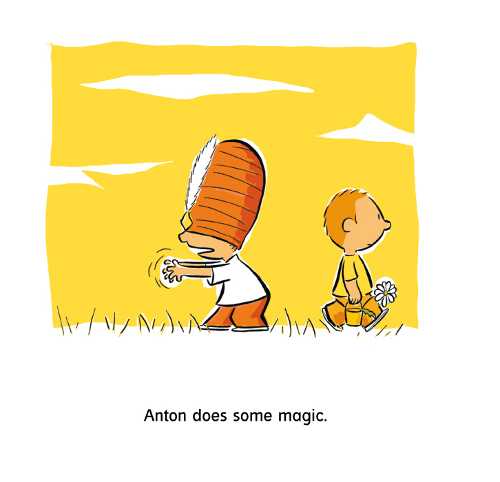
(Featured on September 23, 2011)
Featured on October 5, 2011

(Featured on April 8, 2011)

(Featured on November 24, 2011)

— From Meg Medina, Tía Isa Wants a Car (Candlewick, June 2011),
illustrated by Claudio Muñoz
(Featured on June 24, 2011)

‘Hot, hot roti for Dada-ji!’ he announced in his biggest voice.”
— From F. Zia’s Hot, Hot Roti for Dada-ji (Lee & Low Books), illustrated by Ken Min (Lee & Low Books, May 2011)
(Featured on August 5, 2011)
(Featured on April 21, 2011)
(Click to enlarge spread)
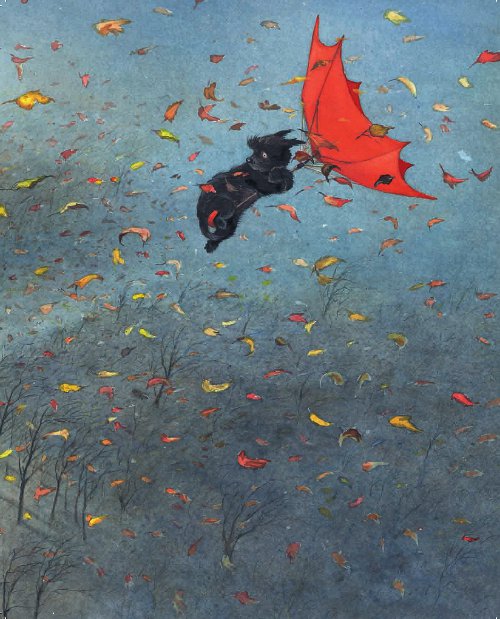
(Featured on January 13, 2011)
— From Patricia Rusch Hyatt’s The Quite Contrary Man,
illustrated by Kathryn Brown (Abrams, May 2011)
(Featured on June 3, 2011)
(Click spread to enlarge)
— From Maria van Lieshout’s Hopper and Wilson (Philomel, May 2011)
(Featured on May 24, 2011)
(Click to enlarge)
— From Chris Van Allsburg’s Queen of the Falls (Houghton Mifflin, April 2011)
(Featured on March 7, 2011)
(Click to enlarge and see entire spread from which this illustration comes.)
(TOON Books, February 2011)
(Featured on June 10, 2011)
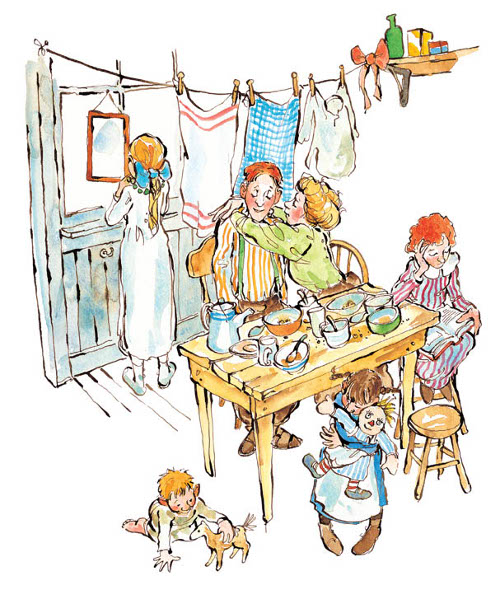
— From Brock Cole’s The Money We’ll Save
(Farrar, Straus and Giroux, October 2011)
(Featured on December 1, 2011)
‘Heart and Soul’ — yes, I can.”
— From Margaret H. Mason’s These Hands (Houghton Mifflin, March 2011), illustrated by Floyd Cooper
(Featured on April 19, 2011)
(Click to enlarge spread)
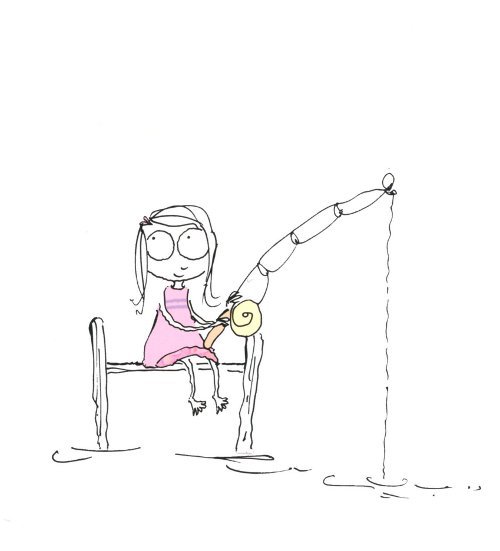
(Featured on June 22, 2011)

— From Monica Brown’s Pablo Neruda: Poet of the People
(Henry Holt, March 2011), illustrated by Julie Paschkis
(Featured on April 8, 2011)

(Featured on October 25, 2011)

(Featured on June 30, 2011)
‘I thought … something was crashing through the lobby … We … huddled down at the base of the escalator. [The] whole area … became totally black,’ Pfiefer said.
‘We stayed there until the rumbling stopped.
I never even suspected that the second tower collapsed.'”
— From Don Brown’s America is Under Attack: September 11, 2001:
The Day the Towers Fell (Roaring Brook, August 2011)
Featured on September 9, 2011
(Click to enlarge)

(Featured on October 14, 2011)

Featured on December 16, 2011

illustrated by Lauren Tobia (Kane Miller, June 2011)
(Featured on October 13, 2011)

A kid smiles down at her. StingRay smiles back.”
— From Emily Jenkins’ Toys Come Home: Being the Early Experiences of an Intelligent Stingray, a Brave Buffalo, and a Brand-New Someone Called Plastic (Schwartz & Wade, September 2011), illustrated by Paul O. Zelinsky
(Featured on September 29, 2011)
beware of the bandits that prowl through the night.”
— From Johanna Wright’s Bandits (Neal Porter/Roaring Brook, August 2011)
Featured on July 11, 2011
(Click to enlarge)
And last, but far from least, my favorite picture book spread from all of 2011 (along with some early sketches) from Lane Smith’s Grandpa Green (Roaring Brook, August 2011), which was featured on September 1, 2011. You can click each image to embiggen it:
(If you don’t click to enlarge this beautiful spread,
you will be missing out)
Copyright note: If I were to list all the copyright notices for these images here, well, you’d find me slumped over my keyboard. Here’s my plea: Please be cool, current and potential readers, and remember all rights reserved and all that good stuff. Also, in all instances the original copyright notices for the image or artwork you see should be listed at the post (interview, feature, what-have-you) from which the above snippets come, since I’m a stickler about including copyright info. If you link back to the original post for many of these, you will see copyright notices. Bottom line: Don’t steal. These weren’t mine to begin with. I had to ask to get them, so please do the same. Thanks.
As a reminder, ALL (not just 2011) of 7-Imp’s author interviews are archived here at the site, and all illustrator/artist interviews and features are archived here. I also always update those lists, ’cause that’s just how I roll.
The mysterious and surly-looking Alfred (he’s really a softie, I swear), who opens this post, is © 2009 Matt Phelan. Alfred not only introduces the Pivot Questionnaire for each of my breakfast interviews; he also grinds my coffee in the mornings before I post and as I set the table for my guests.

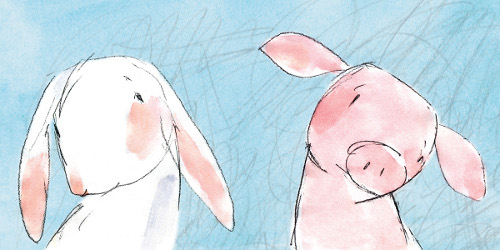






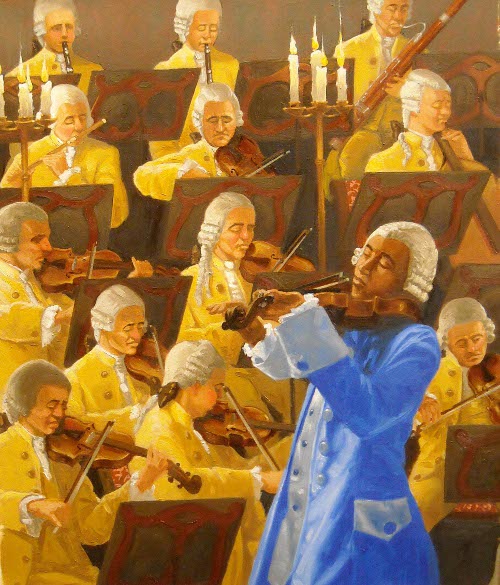


















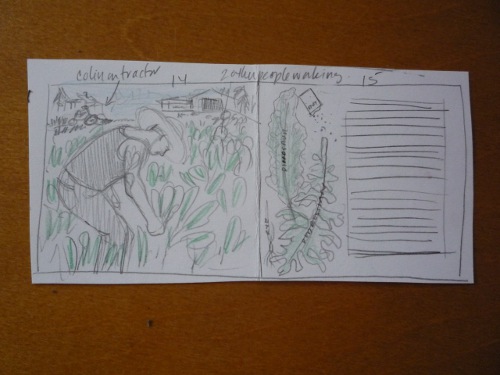









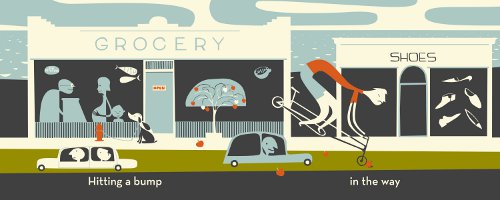







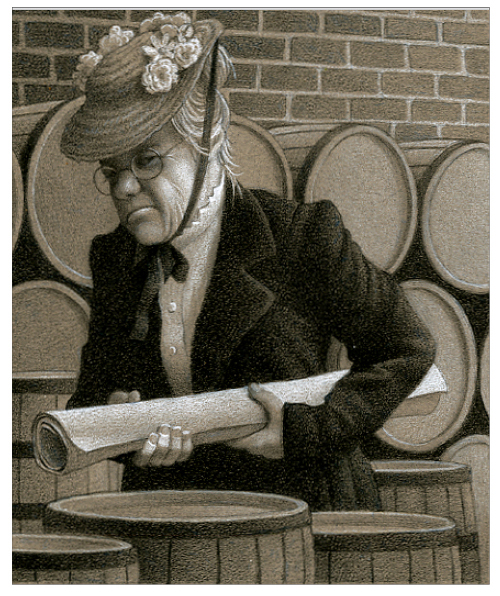





a.jpg)
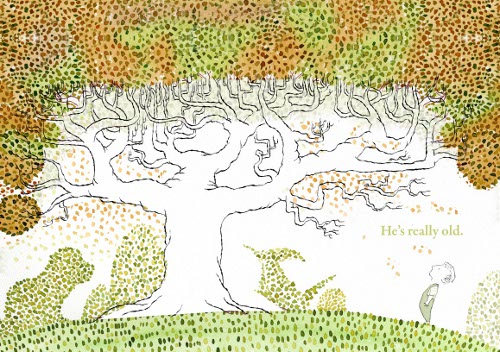
-a.jpg)
a.jpg)

What an amazing year! Thank you so much for all of your posts and for sharing your love of PBs and children’s literature in general with us in so many ways.
Can’t wait to see what great “new” things 2012 brings!
Wow! What an amazing year and I have devoured every letter/word/picture of it. Thank you. I will need to ponder this entry again tomorrow as there is just too much to revisit all at once. Keep the news of picture books coming and visit more Australian illustrations next year if you can. We have some really good illustrators and picture book makers here and I would love to see what you think.
It truly has been a glorious year for picture books. So many I might have missed, I did not thanks to you for featuring them here. I can not begin to imagine how many hours it took you to compile this post, a labor of love to be sure. I have less space on my shelves but what a joy it is to hold and gaze upon these wonderful books. I will be coming back to this post again and again to add more titles to my must see list. As lovely as the illustrations are here, to see them “in person” is so much better. I actualy gasped when I held my personal copy of One Starry Night for the first time. Thank you so much, Jules.
Thanks for this extensive wrap-up, Jules. I’ve missed a lot of these books (northern Vermont has great independent bookstores, but they’re not huge) and it’s more than impressive to see so much creativity all at once. Wow.
This is like the High School Yearbook for kids’ book authors. Proud to be a part of this group! And honored to be featured here at the ol’ 7-Imp!
🙂
JJK
“And the winner for the best year end wrap up goes to…JULES!”
What an undertaking. Thank you, thank you.
This year end review is remarkable. The substance, background, artwork, creativity – it’s a stunning compilation you’re put together. I love what John Rocco said above. That comment made me laugh and smile and it’s true so I’ll second it: the winner for best year end wrap up goes to 7 Impossible Things’ Jules!!!!!!!! STUNNING. I’m going to read it several times. Love seeing all the artwork, too.
These many morsels make a satisfying meal. Thanks for the round-up!
Happy New Year to everyone in and out of their studios.
This blog is one one of the best things about the internet at large, and your annual recap post is always one of my favorite moments of the year. THANK-YOU!
Thank you for this, Jules. It reinforces my sense that in spite of this and that and the other thing, 2011 was an amazing year.
Really enjoyed the wrap-up, and honored to see StingRay in there. Thanks for sending the link.
Thank you, Jules.
Wow. What an amazing year in picture books/illustration. What an amazing 5 years for 7-Imp.
[…] One Very Possible2011 7-Imp Retrospective Before Breakfast December 29th, 2011    by jules […]
Such a fabulous year. So love Jack Gantos! Here’s to a wondrous 2012.
Wow. That is all I can say. Well, other than “really, wow.” Great stuff, and great year, and can’t wait for all the posts this year, too.
Wow, wow, wow, wow, repeat times 10….what a fun and amazing wrap-up!! Even the links are like fine chocolates–you can’t stop sampling every little piece. So glad you’re here to let us see all this great stuff at once. Where else could that happen?
What a feast for the eyes! Thank you and here’s to all good things in 2012.
This is an amazing year-end wrap-up! I have “read” it twice and both times discovered some wonderful, insightful thoughts on illustrating picture books. I have also enjoyed seeing photographs of authors and illustrators who I have only, up to now, known by name.
Oh. my. gosh.
Gorgeous.
This morning I gobbled.
I will need to come back and savor.
Again.
And again.
Thank you so much!
Mary Lee Hahn just shared the link to this finale, & I am happy she did so. What a wonderful, filled-to-the-brim glass of champagne to savor & to use to toast 2012. I will return more than once to look and look. Thank you!
Dear, dear, dear Jules!!!!! I have to THANK YOU for having me contributing on 7Imp!!!! I’m really honoured and proud of it 🙂
Also, this is fun: you picked Sophie Blackall’s “Bear Siut” image, the same I have in my room… Horray to my one and only incredible pal!!!!!!
What an amazing roundup- you had a busy year! This has just increased my wish list exponentially.
I wish I could buy these works for my wall! Seems a shame to keep them hidden inside books I only read a few times!
[…] all know how I like to do 7-Imp year-end recaps (here was last year’s), on account of being a ginormous nerd? I’m working on 2012’s […]
[…] nerd, who enjoys recaps. As I’ve said during the past couple of years, including during 2011’s recap, this is fun to me. Also, it satisfies the tremendous picture book junkie in […]
[…] don’t want to miss the 2011 Retrospective for Julie Danielson’s 7 Impossible Things Before Breakfast blog that includes interviews with Brian […]